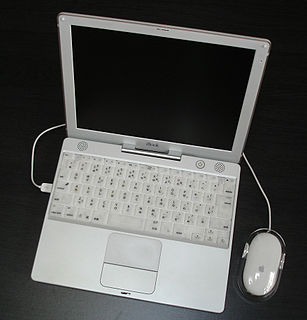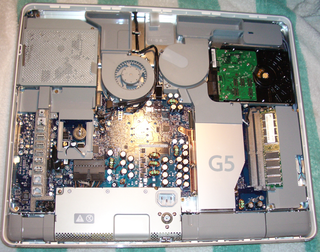
A motherboard is the main printed circuit board (PCB) in general-purpose computers and other expandable systems. It holds and allows communication between many of the crucial electronic components of a system, such as the central processing unit (CPU) and memory, and provides connectors for other peripherals. Unlike a backplane, a motherboard usually contains significant sub-systems, such as the central processor, the chipset's input/output and memory controllers, interface connectors, and other components integrated for general use.

The Power Macintosh, later Power Mac, is a family of personal computers designed, manufactured, and sold by Apple Computer, Inc. as part of the Macintosh brand from March 1994 until August 2006.

A desktop computer is a personal computer designed for regular use at a single location on or near a desk or table due to its size and power requirements. The most common configuration has a case that houses the power supply, motherboard (a printed circuit board with a microprocessor as the central processing unit, memory, bus, and other electronic components, disk storage ; a keyboard and mouse for input; and a computer monitor, speakers, and, often, a printer for output. The case may be oriented horizontally or vertically and placed either underneath, beside, or on top of a desk.

iBook is a line of laptop computers designed, manufactured, and sold by Apple Computer, Inc. from 1999 to 2006. The line targeted entry-level, consumer and education markets, with lower specifications and prices than the PowerBook, Apple's higher-end line of laptop computers. It was the first mass consumer product to offer Wi-Fi network connectivity, which was then branded by Apple as AirPort.

The Power Macintosh G3 is a series of personal computers designed, manufactured, and sold by Apple Computer, Inc. from November 1997 to August 1999. It represented Apple's first step towards eliminating redundancy and complexity in the product line by replacing eight Power Macintosh models with three: Desktop and Mini Tower models for professional and home use, and an All-In-One model for education. The introduction of the Desktop and Mini Tower models coincided with Apple starting to sell build-to-order Macs directly from its web site in an online store, which was unusual for the time as Dell was the only major computer manufacturer doing this. Apple's move to build-to-order sales of the Power Macintosh G3 also coincided with the acquisition of Power Computing Corporation, which had been providing telephone sales of Macintosh clones for more than two years.

The Macintosh SE is a personal computer designed, manufactured, and sold by Apple Computer, from March 1987 to October 1990. It marked a significant improvement on the Macintosh Plus design and was introduced by Apple at the same time as the Macintosh II.

The Macintosh 128K, originally released as the Apple Macintosh, is the original Apple Macintosh personal computer. Its beige case consisted of a 9 in (23 cm) CRT monitor and came with a keyboard and mouse. A handle built into the top of the case made it easier for the computer to be lifted and carried. It had an initial selling price of $2,495. The Macintosh was introduced by the now-famous $370,000 television commercial directed by Ridley Scott, "1984", which aired on CBS during the third quarter of Super Bowl XVIII on January 22, 1984. Sales of the Macintosh were strong from its initial release on January 24, 1984, and reached 70,000 units on May 3, 1984. Upon the release of its successor, the Macintosh 512K, it was rebranded as the Macintosh 128K. The computer is Model M0001.

The Power Macintosh 7500 is a personal computer designed, manufactured and sold by Apple Computer, Inc. from August 1995 to May 1996. The 7500 was introduced alongside the Power Macintosh 7200 and 8500 at the 1995 MacWorld Expo in Boston. Apple referred to these machines collectively as the "Power Surge" line, communicating that these machines offered a significant speed improvement over its predecessors. The 7500 introduced a new case design, later dubbed "Outrigger" by Mac enthusiasts. There were two derivative models: the Power Macintosh 7600, identical to the 7500 except for the CPU which was a PowerPC 604 or 604e processor instead of the 7500's 601; and the Power Macintosh 7300, identical to the 7600 but without the video inputs found in both the 7500 and 7600.

The Power Macintosh 7600 is a personal computer designed, manufactured and sold by Apple Computer, Inc. from April 1996 to November 1997. It is identical to the Power Macintosh 7500, but with a PowerPC 604 CPU. Three models were available with 120 MHz, 132 MHz and 200 MHz processors. Like the 7500, it includes advanced Audio-Video ports including RCA audio in and out, S-Video in, composite video in and standard Apple video ports. The 7600 features the easy-access "outrigger" desktop case first introduced with the Power Macintosh 7500. It was eventually replaced by the Power Macintosh 7300, one of the very few times that Apple updated a computer but gave it a lower model number - the reason is that the 7300 was a joint replacement for the 7600 and the Power Macintosh 7200.
The Apple Network Server (ANS) was a line of PowerPC-based server computers designed, manufactured and sold by Apple Computer, Inc. from February 1996 to April 1997. It was codenamed "Shiner" and originally consisted of two models, the Network Server 500/132 and the Network Server 700/150, which got a companion model, the Network Server 700/200 with a faster CPU in November 1996.

The Macintosh Quadra 605 is a personal computer designed, manufactured, and sold by Apple Computer, Inc. from October 1993 to July 1996. The model names reflect a decision made at Apple in 1993 to follow an emerging industry trend of naming product families for their target customers – Quadra for business, LC for education, and Performa for home. Accordingly, the Performa 475 and 476 was sold in department stores and electronics stores such as Circuit City, whereas the Quadra was purchased through an authorized Apple reseller.

The Power Macintosh 4400 is a personal computer designed, manufactured and sold by Apple Computer, Inc. from November 1996 to February 1998. It differs from prior desktop Macintosh models in that it was built with industry-standard components such as an IDE hard drive and an ATX-like power supply.

The Power Macintosh 6200 is a series of personal computers designed, manufactured, and sold by Apple Computer, Inc. from May 1995 to July 1997. The 6200 is the PowerPC-based replacement for the Quadra 630, with the same form factor and price range. In early 1997, the rather different Power Macintosh 6300/160 / Performa 6360 based on the Power Macintosh 6400 was introduced. The whole line was discontinued when the desktop model of the Power Macintosh G3 was released.

The Power Macintosh 7300 is a personal computer designed, manufactured and sold by Apple Computer, Inc. from February 1997 to November 1997. It was introduced with 166, 180 and 200 MHz CPUs in February 1997 alongside the Power Macintosh 8600 and 9600. The 7300 replaced both the Power Macintosh 7200 and 7600, replacing the only remaining first-generation PowerPC system in Apple's lineup. MacUser Magazine's review says the 7300 "offers the most satisfying improvement" of the new machines introduced in early 1997 due to a significant performance jump from its predecessors, as well as offering 50% faster CD-ROM and hard disk space. The 7300 was replaced by the Power Macintosh G3 desktop model in November 1997. Workgroup Server 7350 continued to be sold until March 1998 when the Macintosh Server G3 was introduced.

The Power Macintosh 7200 is a personal computer designed, manufactured, and sold by Apple Computer, Inc. from August 1995 to February 1997. The 90 MHz model was sold in Japan as the Power Macintosh 7215, and the 120 MHz model with bundled server software as the Apple Workgroup Server 7250. When sold as the 8200, it used the Quadra 800/Power Mac 8100's mini-tower form factor.

The Power Macintosh 9600 is a personal computer that is a part of Apple Computer's Power Macintosh series of Macintosh computers. It was introduced in February 1997 alongside the Power Macintosh 7300 and 8600, and replaced the Power Macintosh 9500 as Apple's flagship desktop computer.

The Power Macintosh 6500 is a personal computer designed, manufactured and sold by Apple Computer from February 1997 to March 1998 as part of the Power Macintosh family. It was introduced with speeds of 225 and 250 MHz, with two faster models at 275 and 300 MHz being added a couple of months later.

The Power Macintosh 5200 LC and Power Macintosh 5300 LC are a line of personal computers that are a part of Apple Computer's Power Macintosh, LC, and Performa families of Macintosh computers. When sold to the consumer market, the machines were marketed as variations of Performa 5200 and Performa 5300.

Hardware of the Macintosh is produced solely by Apple Inc., who determines internal systems, designs, and prices. Apple directly sub-contracts hardware production to external OEM companies, maintaining a high degree of control over the end product. Apple buys certain components wholesale from third-party manufacturers. The current Mac product family uses Intel x86-64 processors, however it is moving to Apple-designed processors until 2022. All Mac models ship with at least 8 GB RAM as standard. Current Mac computers use AMD Radeon or integrated graphics. Macs include two standard data transfer ports: USB and Thunderbolt. USB was introduced in the 1998 iMac G3 and is ubiquitous today; Thunderbolt is intended for high-performance devices such as external graphics cards.


















